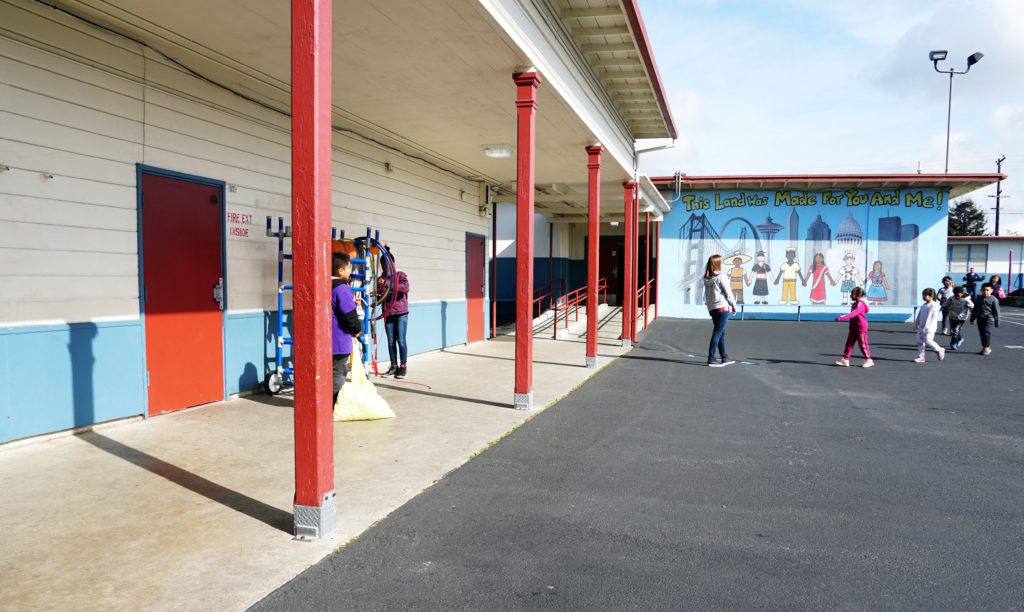
Photo: Andrew Reed/EdSource
A recently filed lawsuit against the West Contra Costa Unified School District could set a new precedent for how districts in California handle and comply with complaints filed by students, educators and community members.
The lawsuit, filed by civil rights law firm Public Advocates last month, alleges the school district failed to remedy issues in the required time frame for nearly 50 “Williams complaints” filed by teachers, students and parents since June 2023. The bulk of the complaints were about poor building conditions at Stege Elementary School, and three were filed about teacher vacancies. There are five complainants, including four educators and a parent, who are suing the district.
West Contra Costa is the first district in the state to be sued under the Williams v. California settlement in 2004, a landmark case that established the Williams complaint process, and the right to textbooks, safe schools and qualified teachers for all California public school students. Public Advocates attorneys led that charge 20 years ago and are now turning to the courts to uphold the standards it set and to stop the unlawful practice of filling full-time teacher positions with rolling substitutes.
“It’s important for districts to know that this is a process that can be enforced by the courts, and they can be subject to a court order when they don’t abide by this specific process,” said Dane Shikman, attorney with Munger, Tolles, & Olson LLP, who is assisting with the lawsuit.
Public Advocates attorney Karissa Provenza said she hopes the lawsuit sets a precedent and that other districts that aren’t complying with the Williams complaint process “fall in line.”
The law firm has kept a close watch on West Contra Costa for years, and Provenza has spent the last few years building relationships with educators, organizers and families. But it shouldn’t just be those districts that Public Advocates attorneys are watching that are held accountable.
“We know there are issues across the board when it comes to districts following through with Williams complaints,” Provenza said. “We’re hoping this (lawsuit) can stand out.”

Anyone can file a Williams complaint, and school districts have up to 30 days to fix the issue and 45 days to respond to the complaint in court. District officials responded to the 45 building condition complaints at Stege Elementary School six months later, and only after plaintiffs’ attorneys repeatedly reminded the district of its legal obligation, the lawsuit alleges.
“It’s a highly informal process that the districts often get away with something less than a full remedy of the complaints, or they delay on getting a response back,” Shikman said.
According to the lawsuit, West Contra Costa’s response “acknowledged the complaints, cited a nonexistent section of the Education Code, claimed the district had no duty to respond within the statutory 45-day timeline, and promised to provide a substantive response with an update by January 12, 2024.”
That response never came, the lawsuit says.
The complaints said the Richmond school had moldy walls, inoperable windows, classrooms reaching more than 90 degrees without ventilation, and broken floor tiles. Lead and asbestos were also found after the district hired an environmental firm to test building materials.
“One of the worst conditions for the students’ learning and teaching was probably the heat,” said Stege teacher Sam Cleare, who is one of the complainants in the lawsuit. “My first year there, we even watched crayons melt outside, but it wasn’t even that much hotter outside than it was inside.”

Building conditions at Stege Elementary were never improved, and district officials have “repeatedly” acknowledged conditions at Stege were “dangerous,” the lawsuit says. Superintendent Chris Hurst announced the school was closing for repairs on July 23, four days after the lawsuit was filed and hazardous materials were detected during the removal of window panels.
District officials did not respond to requests for comment on this story and have previously said they don’t comment on litigation.
Unlawful practices
District officials did respond to the three complaints about teacher vacancies, the lawsuit says, but the positions weren’t filled within 30 days and solutions weren’t reported.
Hurst addressed teacher vacancies at a recent board meeting and said the district is “working hard” to fill all positions before the start of the school year this week. The district has posted on job boards and social media platforms, attended job fairs and is partnering with residency programs to recruit teachers.
“But the district’s statutory mandate is not just to ‘try hard’ to recruit teachers; it is to actually provide every student with a permanent, qualified teacher,” the lawsuit says.
If positions aren’t filled, the district’s plan is to fall back on substitutes, which is the reason teacher vacancy complaints were filed in the first place. The complaints said it was illegal to rely on substitutes long-term and in the district’s response, officials acknowledged its practices were unlawful.
Provenza said she is not surprised the district continues to rely on substitutes.
“I wish I could start hearing that they were going to start shifting their ways, but unfortunately, it seems like relying unlawfully on substitutes is something that they’re going to continue to do,” Provenza said.
The district has relied on day-to-day, 30-day, and 60-day substitutes to fill teacher vacancies. Teachers have also had to pick up extra classes or have had students added to their classrooms, often from different grades. This school year, the district is also asking credentialed staff who aren’t usually in the classroom to step in.
“Substitutes did not follow curricula or assign homework as a dedicated year-long educator would have, and students in those classrooms were denied the stability and consistency that a permanent qualified teacher provides,” the lawsuit says.
Complaints were filed at Stege Elementary, Helms Middle and Kennedy High schools, some of the district’s highest-need schools, where more than 80% of students are low-income. Substitutes were used for an entire school year in some classes, the lawsuit says.
Some students at Kennedy High weren’t sure they would receive grades at the end of the last school year because they never had a permanent teacher, according to the lawsuit. Permanent teachers weren’t assigned to an English language development class, a reading and writing class, a P.E. class, and two music classes.
Most of Kennedy’s students are Hispanic or Latino and Black or African American — 73% and 18% respectively in the 2022-23 school year, the most recent year of available state data. That same school year, 84% of students did not meet grade-level math standards and nearly 58% did not meet reading standards.
A math, science and English class at Helms Middle did not have permanent teachers the last school year, the lawsuit alleges. Nearly 70% of Helms students did not meet grade-level literacy standards and 82% did not meet math standards for the 2022-23 school year, data shows.
Helms Middle mostly serves Hispanic and Latino students, almost 83% in the 2022-23 school year. The next largest population is Black or African American, about 7%. Almost half the students (47%) are also English learners.
There weren’t permanent teachers in a kindergarten, third grade, fourth grade, and second and third grade split class at Stege Elementary last year, according to the lawsuit.
Most of the student population is Black or African American, nearly 39% in the 2022-23 school year, and Hispanic or Latino, 34%. About 73% of students did not meet grade-level standards in math and 75% did not meet literacy standards.
The lawsuit calls the teacher vacancy problems in the district a “crisis.”
West Contra Costa “faces more teacher vacancies than its neighboring districts and continuously under performs in retaining fully prepared and properly assigned teachers,” the lawsuit says. “Quality teachers are the leading school-related factor contributing to a student’s success.”
Students have complained to the board during public comment about teacher vacancies this past school year, saying they aren’t motivated to attend class with consistently different teachers. One high school student said they weren’t learning any new materials in math class.
According to the lawsuit, the district hasn’t reported any solutions to fill teacher positions and blamed the vacancies on the statewide teacher shortage. The lawsuit gave various solutions, including assigning certified teachers of other subjects to vacant classes, using emergency teaching permits, and hiring university interns and retired teachers.
Last year, West Contra Costa did tap into retirees to help fill vacancies, but it’s unclear how many and if these efforts are continuing. The district has said it can’t hire retired teachers for a full school year, the lawsuit alleges, but attorneys claim that under SB 765, districts can do so.
Problems filling teacher vacancies are also connected to poor working environments, Provenza said. It’s difficult to attract and retain teachers when they don’t feel supported, are overworked, and lose prep periods to cover other classes.
‘This year made staying very challenging’
Educators, parents and community members have fought for better conditions at Stege Elementary for years, and for teacher Sam Cleare, her advocacy efforts began with the 45 Williams complaints.
She called the conditions at Stege “inhumane” and “unbearable” and said there was nowhere to escape the heat.
“Students felt sick,” Cleare said. “I felt lightheaded. Not only was it difficult or impossible to learn, but it felt unsafe as well.”

Cleare remembers the windows starting to fall apart when trying to open them and said once she cut her finger on the edge of a window. She taught at Stege for the last seven years, and said it was her dream to retire there. But she’s decided to take a job with the teachers union.
“I will miss working at Stege terribly, but this year made staying very challenging,” Cleare said. “Many teachers struggle to stay at the school due to the working conditions.”
On top of teacher vacancies, Stege has battled dwindling enrollment, chronic absenteeism and a long-awaited renovation for nearly a decade. The building was slated to be remodeled by the 2020-21 school year, but there have been delays. Last November, the board approved an increased budget for renovations, from $2.9 million to $43 million, because of the severe need for repairs.
Parents and community members have been frustrated by the delays and lack of funding going toward repairs. The concerns resurfaced at a Stege community meeting last week when parents were calling out district officials for not addressing the health hazards and safety concerns sooner.
District officials shared an annual report on Stege with the community, the Facility Inspection Tool, a visual inspection that determines if a school needs repairs. According to the report, Stege received a “good” rating, which means “the school is maintained in good repair with a number of non-critical deficiencies noted. These deficiencies are isolated, and/or resulting from minor wear and tear, and/or in the process of being mitigated.”
Meeting attendees were outraged by the conclusion of the inspection, which was done last August, and said it was offensive. Parents and educators told stories about sewage coming out of the toilets when flushing, drywall issues, and complained that students were subject to unhealthy conditions.
With the temporary closure of Stege Elementary, students and staff are starting the 2024-25 school year at Dejon Middle School.
)

